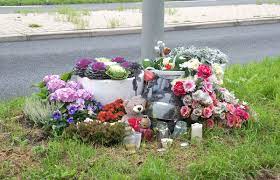I am always in awe when I drive past roadside memorials. They commemorate the place where someone was killed in a motor vehicle crash. They grew in popularity following the of MADD, Mother’s Against Drunk Driving first in the 1980’s in Austin, Texas. These are usually a white cross along with trinkets, toys, and photos that memorialize them life or lives that were lost at the location. Many are painted with the names of people who have lost their lives too. What strikes me is who maintains the site? Is there any sort of memorial at a internment site? Do the same people who maintain the shrines also maintain a grave site?
There is a psychology to the roadside memorials that are dotted across our country’s roadways commemorating the lives of people who have perished. Usually these are simple crosses sometimes emboldened by the name or names of people who may have been in fatal accidents at the location. Others grow to become memorials to a lost love one and are maintained by grieving family members. I seem to see them everywhere and wonder about the survivors. Do they visit the site? It is different then a cemetery in that this is not the place where they were laid after death, but this is the last place on earth their loved one was alive.
I am reading a couple of books about roadside memorials with interest. One is a thesis from a Canadian university, authored by Holly Everett from Memorial University in Newfoundland. These sites are also known as the “spontaneous shrines” that result from a public outpouring of grief according Everett who studied the shrines in Texas as part of her graduate work. It makes me sad when someone builds a spontaneous shrine to honor the loss of someone. On my way to work a few months go, I noticed that 2 crosses were erected in a tree near my home. A spontaneous shrine.
While working as a police officer I noticed these spontaneous shrines popping up in our town usually after a fatal accident. Fortunately, we had very few fatal crashes in the 12 years I worked. Towns everywhere, including the one in which I patrolled, were discussing regulations about the roadside crosses and all the stuff that accumulated along with them. Our chief was sympathetic but the one or two shrines in our town became a traffic hazard in his mind. Cars (I assume family members or friends) would slow or stop for a short visit. We always worried about someone getting injured or killed on the site of one of the crosses. And we had a call to the cross on Rt 67. The boyfriend of one of the victims was sleeping at the cross site. Upon further investigation we learned that he was so grieved that he wanted to stay with the girlfriend’s cross one last time. Sadly, we had to send him along because having a sleeping person on a busy road caused too much public concern. Communities are needing to regulate these sites because the grieving public tends to add more and more to them. Some family members even mow grass or shovel snow keeping the site looking prosperous. According to the draft policy posted on the BBC site, “locations and content of roadside memorials will be vetted for safety and messages that can be considered “offensive” will be banned, as will any sort of illumination or materials that can shatter, such as glass” January, 2022
It struck me that the first names were imprinted on white crosses leaving off the last names of the two boys who died at the site. I would have liked to know the last names. I wanted offer my condolences in some way. Maybe I had seen them riding bikes in the neighborhood just recently, at least until one of them earned his driver’s license.

